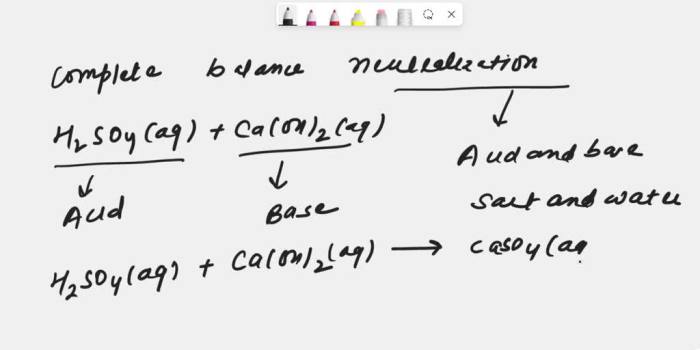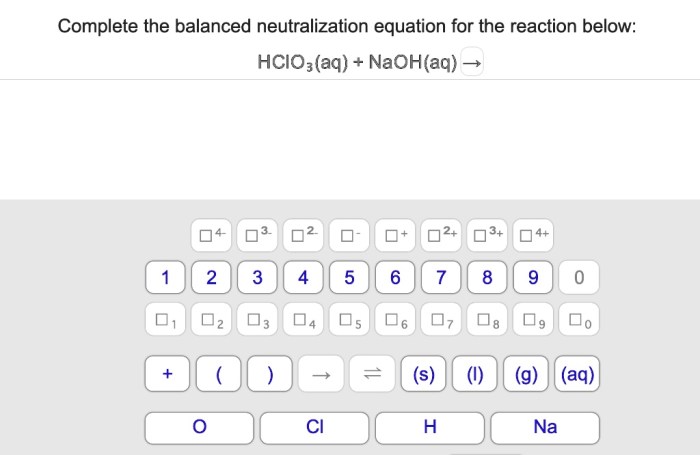Complete the balanced neutralization equation for the reaction below introduces a captivating journey into the realm of chemical reactions, where acids and bases engage in a dance of neutralization, resulting in the formation of salts and water. This comprehensive guide unravels the intricacies of balancing chemical equations, providing a step-by-step approach to ensure accuracy and a deeper understanding of these fundamental reactions.
Delving into the heart of the matter, we will explore the concepts of neutralization reactions, unravel the process of balancing chemical equations, and delve into the practical applications of these reactions in various fields, from everyday life to industrial processes.
Along the way, we will encounter intriguing examples and engage with frequently asked questions, shedding light on the complexities of neutralization reactions.
Neutralization Reactions: Complete The Balanced Neutralization Equation For The Reaction Below

Neutralization reactions are chemical reactions between an acid and a base, resulting in the formation of a salt and water. These reactions are characterized by the complete consumption of both the acid and base, leading to a neutral solution.
Balancing chemical equations is essential to ensure that the number of atoms of each element on the reactants’ side of the equation equals the number of atoms of the same element on the products’ side. This is achieved by adjusting the stoichiometric coefficients in front of each chemical formula.
Steps to Balance the Neutralization Equation
- Identify the reactants and products involved in the reaction.
- Write the unbalanced equation, including the chemical formulas of the reactants and products.
- Balance the equation by adjusting the coefficients in front of each chemical formula. Start by balancing the atoms that appear in the greatest number of molecules. Continue balancing the remaining atoms until the equation is balanced.
- Check if the equation is balanced by verifying that the number of atoms of each element is the same on both sides of the equation.
Examples of Neutralization Reactions
| Reactants | Products | Balanced Equation |
|---|---|---|
| Hydrochloric acid (HCl) + Sodium hydroxide (NaOH) | Sodium chloride (NaCl) + Water (H2O) | HCl + NaOH → NaCl + H2O |
| Sulfuric acid (H2SO4) + Potassium hydroxide (KOH) | Potassium sulfate (K2SO4) + Water (H2O) | H2SO4 + 2KOH → K2SO4 + 2H2O |
| Nitric acid (HNO3) + Calcium hydroxide (Ca(OH)2) | Calcium nitrate (Ca(NO3)2) + Water (H2O) | 2HNO3 + Ca(OH)2 → Ca(NO3)2 + 2H2O |
Applications of Neutralization Reactions
- Neutralization reactions are used in everyday life for various purposes, such as:
- Antacids to neutralize stomach acid
- Cleaning agents to remove acidic or alkaline stains
- Water treatment to adjust pH levels
- In industries, neutralization reactions are employed in processes such as:
- Manufacturing of fertilizers
- Production of pharmaceuticals
- Wastewater treatment
- Neutralization reactions also occur naturally in the environment, contributing to the regulation of pH levels in ecosystems.
Advanced Concepts, Complete the balanced neutralization equation for the reaction below
Equivalent weightsin neutralization reactions refer to the mass of an acid or base that can neutralize a fixed amount of the other. This concept is useful in determining the stoichiometric proportions of reactants in neutralization reactions.
pH, a measure of the acidity or alkalinity of a solution, plays a crucial role in neutralization reactions. The pH of a solution at the equivalence point, where the acid and base have completely reacted, is typically around 7, indicating a neutral solution.
Titrationis a technique used to determine the concentration of an acid or base by gradually adding a known concentration of the other reactant until the equivalence point is reached. This method relies on the principles of neutralization reactions.
Question & Answer Hub
What is the purpose of balancing chemical equations?
Balancing chemical equations ensures that the number of atoms of each element on the reactants’ side of the equation matches the number of atoms of that element on the products’ side. This adherence to the law of conservation of mass is crucial for accurate representation of chemical reactions.
How do I know if a chemical equation is balanced?
A chemical equation is balanced when the number of atoms of each element on the reactants’ side of the equation is equal to the number of atoms of that element on the products’ side. You can check this by counting the number of atoms of each element on both sides of the equation.
What is the role of pH in neutralization reactions?
pH plays a crucial role in neutralization reactions as it indicates the acidity or alkalinity of a solution. During neutralization, the pH of the solution changes as the acid and base react, eventually reaching a neutral pH of 7 when the reaction is complete.


